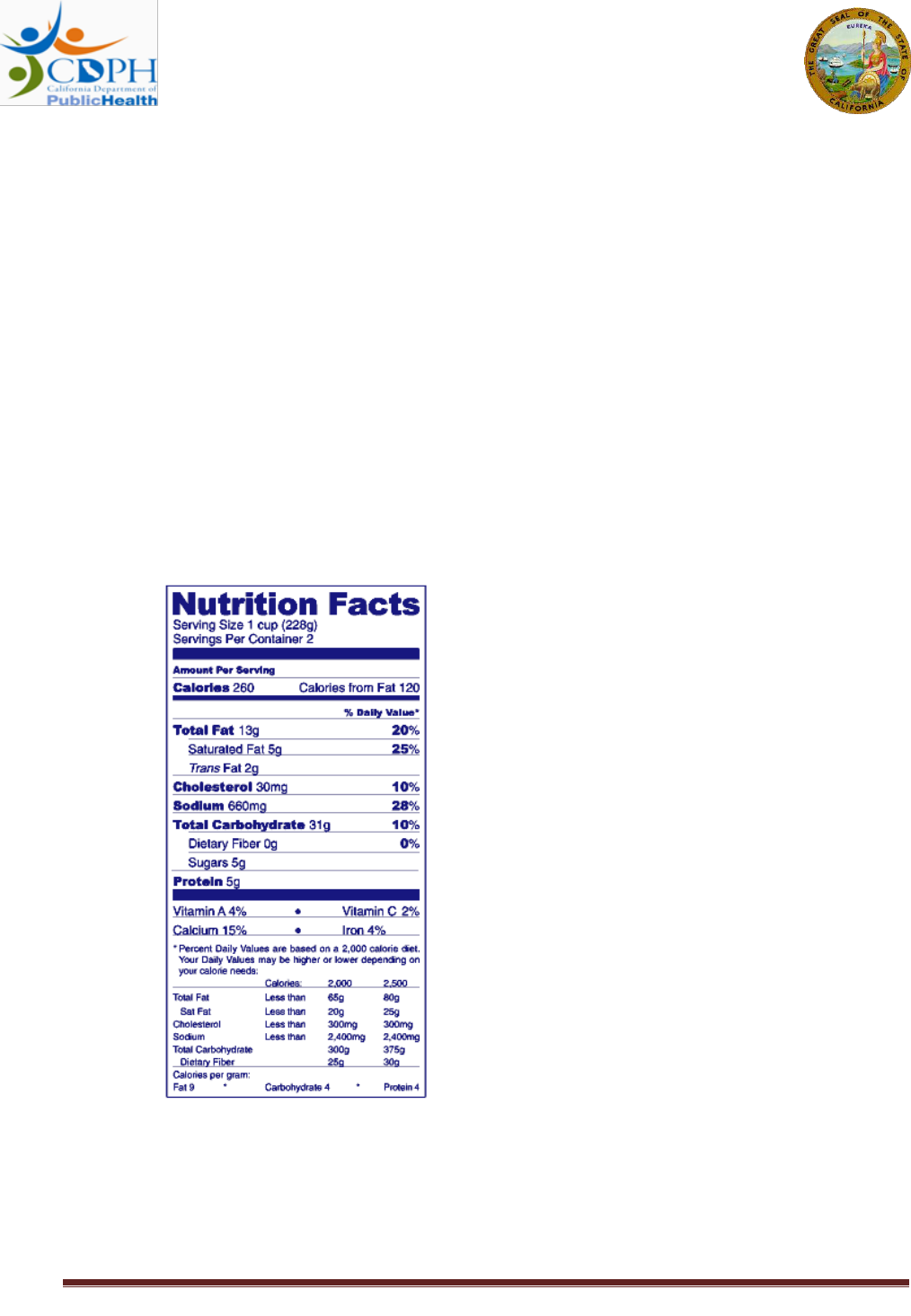
Labeling Requirements for Cottage Food Products
Cottage food products are required to be labeled in accordance with specific state and federal
labeling regulations. The following list of labeling requirements is intended to assist cottage
food operations (CFOs) in complying with basic labeling laws and regulations.
Packaged, processed food labels usually have two distinct areas: the Principal Display Panel
(aka: Primary Display Panel) and the Information Panel. The principal display panel information
is the part of the label the consumer will see first and is usually located on the front of the
package. This panel lists the product name and net quantity of contents. The information
panel is usually located to the immediate right of the principle display panel and contains the
nutrition facts statement. Computer generated labels affixed to cottage food products may list
all required information on the principle display panel, provided that the information is
displayed in a size and manner that will allow the information to be read by the average
consumer.
A comprehensive guide to labeling requirements and regulations for processed foods is available
at general food labeling requirements. Additionally, complete federal labeling requirements
may be found in the Federal Food, Drug, and Cosmetic Act available at 21 U.S.C. Sec. 343 et seq.
and 21 CFR Part 101.
Labels on cottage food products must contain the following information:
(1) The common or descriptive name of the CFO food product located on the primary
(principal) display panel.
(2) The name, city, and zip code of the CFO operation which produced the cottage food
product. If the CFO is not listed in a current telephone directory, then a street address
must also be included on the label. (A contact phone number or email address is optional
but may be helpful for contact in case a consumer wishes to contact you.
(3) The words “Made in a Home Kitchen” o r “ Repackaged in a Home Kitchen” as
applicable, in 12-point type must appear on the principal display panel. *Note: if
labeled as “Repackaged in a Home Kitchen” then a description of any purchased ready-to-
eat products not used as an ingredient must also be included on the label.
(4) The registration or permit number of the CFO which produced the cottage food product
and the name of the county of the local enforcement agency that issued the permit
number.
(5) The ingredients of the cottage food product, in descending order of predominance by
weight, if the product contains two or more ingredients.
Cottage Food Labeling Page 1

(6) The net quantity (count, weight, or volume) of the food product, stated in both English
(pound) units and metric units (grams).
(7) A declaration on the label in plain language if the food contains any of the major food
allergens such as milk, eggs, fish, shellfish, tree nuts, wheat, peanuts, and soybeans. There
are two approved methods prescribed by federal law for declaring the food sources of
allergens in packaged foods:
a) in a separate summary statement immediately following or adjacent to the ingredient
list, or
b) within the ingredient list.
See an example of a cottage food label below (principal display panel):
MADE IN A HOME KITCHEN
Permit #: 12345
Issued in county: County name
Chocolate Chip Cookies With Walnuts
Sally Baker
123 Cottage Food Lane
Anywhere, CA 90XXX
Ingredients: Enriched flour (Wheat flour, niacin, reduced iron, thiamine,
mononitrate, riboflavin and folic acid), butter (milk, salt), chocolate chips
(sugar, chocolate liquor, cocoa butter, butterfat (milk), walnuts, sugar, eggs,
salt, artificial vanilla extract, baking soda.
Contains: Wheat, eggs, milk, soy, walnuts
Net Wt. 3 oz. (85.049g)
(8) The use of the following eleven terms are considered nutrient content claims (nutritional
value of a food): free, low, reduced, fewer, high, less, more, lean, extra lean, good source,
and light. The Federal Food and Drug Administration has set conditions for the use of
these terms. (For details, please refer to 21 CFR Sections 101.13 and 101.54 et seq.)
For example: the term “sodium free” means that the food contains less than 5
milligrams of sodium per serving of the food.
Cottage Food Labeling Page 2

(9) A health claim is a statement or message on the label that describes the relationship
between a food component and a disease or health-related condition (e.g., sodium and
hypertension, calcium and osteoporosis). Health claims, if used, must conform to the
requirements established in 21 CFR 101.14 and 101.70 et seq.
(10) Nutrition Facts panels will generally not be required for CFOs. If the food label makes any
nutrient content or health claims then a Nutrition Facts Panel is required to be
incorporated into the label. Nutrition information must be declared in a “Nutrition Facts”
statement as indicated in the example below. The categories that are required to be on
the Nutrition Facts panel include: Calories, total fat, saturated fat, trans fat, cholesterol,
sodium, total carbohydrate, dietary fiber, sugar, protein, vitamin A, vitamin C, calcium and
iron. The amount of trans fat must be declared on the nutrition facts panel unless the total
fat in the food is less than 0.5 gram (or ½ gram) per serving and no claims are made about
fat, fatty acid, or cholesterol content. If it is not listed, a footnote must be added stating
the food is “Not a significant source of trans fat.”
See example of “Nutrition Facts” panel below:
(11) Labels must be legible and in English (accurately translated information in another
language is optional).
Cottage Food Labeling Page 3

(12) Labels, wrappers, inks, adhesives, paper, and packaging materials that come into contact
with the cottage food product by touching the product or penetrating the packaging must
be food-grade (safe for food contact) and not contaminate the food.
(13) Whenever a cottage food product is served without packaging or labeling in a permitted
retail food facility or is used as an ingredient in a preparation of a food in a retail food
facility including restaurants, bakeries, or delis, the retail customer must be notified that
the food product or the ingredient in the food was processed in a CFO home kitchen.
Cottage Food Labeling Page 4
